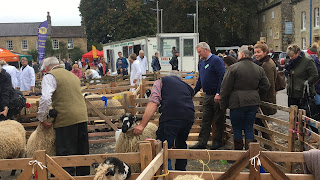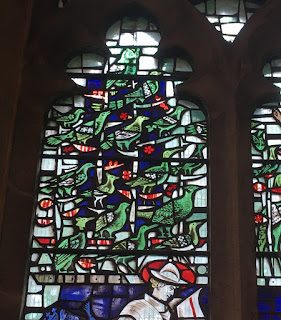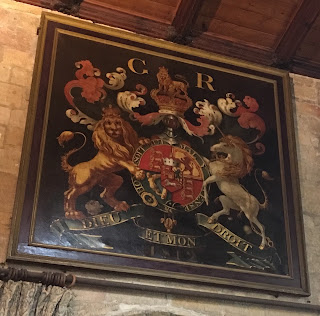I went to Masham on the weekend. Masham is a town in Yorkshire. It has an exceptionally pretty square, which is where the major part of the event that had drawn us to Masham was held. This was the Masham Sheep Fair, usually held in September, but, luckily for us, postponed this year until October so as not to clash with a bicycle race that ran through Yorkshire at the end of September.
The fair was a complete delight. The part that involved actual living sheep and the farmers who raise them reminded me of rural shows in Australia, which I love for the same reasons I loved Masham Sheep Fair. That is, both the sheep fair and Australian country shows are places where rural people can enjoy the things they find interesting and admire each others' skills and no one suggests theirs are not important preoccupations.
Here is one of the sheep classes being judged. I love the arcane knowledge that is involved and I find it poignant that there always has to be a loser, although all entrants, I'm sure, have poured so much energy and emotion into this day and their entrant's qualities:
I became rather fond of this sheep, although I never found out whether it won a prize and I certainly don't possess anywhere near enough knowledge to be able to guess:
While we waited for the main event of the day - the sheep races - we enjoyed this rather wonderful display of Morris dancing. I was moved by the fact that a member of the team has a genetic make up that we are encouraged to make disappear, for convenience's sake, (I'm not condemning anyone who responds to the encouragement, simply mourning the intolerance and lack of kindness that leads to people feeling so unsupported that they feel the need to):
All the dancers made their own hat decorations. I got a close look at one and saw how they attach the flowers with wire like the stuff I remember using at the bottom of vases in my flower arranging days. I thought the tambourine player's was a particularly fine floral display and I was tempted to label this photograph, 'Hey, Mr Tambourine Man', but I was told by one of the Morris Dancing groupies that he wasn't a tambourine player at all but something that began with b, I think, and was originally a gaelic word, (which means tambourine player):
The sheep racing turned out to be as exciting as only a sport involving very unreliable creatures can be (we were assured, by the way, that these sheep had been rigorously trained):
Victorian stained glass is often sneered at, but the church's examples of the same were really very pretty:
Even in the 1950s they could manage something not actually sickening:
But by the time this, "the Masham Millennium Window" was designed the ability to create beauty seems to have been mislaid. Even the authorities who paid for it seemed to have dimly apprehended this, which is why, presumably, they felt it necessary to put a large explanatory notice beside it, telling the viewer what the pictures are of - indeed, revealing to us that those smudges are representations of leaves and various other things and not just, well, smudges:
If you want further proof of the decline in aesthetic standards, I present to you the contemporary altar cloth on display at St Mary's, Masham:
Ugh. You think you are getting away from the disasters of modern art by leaving London during the Frieze Art Fair, but, if you go into any Church of England premises these days, you cannot be sure that you will be safe from equal horrors.
But never mind, there were other lovely things from earlier times to cheer one up in the church.
For a start, these dear faces on either side of the entrance:
And then a real treasure in the form of something called the Wyvill monument (not that the church itself seems to like it very much - as well as a railing half obscuring it, you had to climb behind a screen and over piles of old chairs and a table to get any kind of look at it, almost as if they were a bit ashamed of it):
There was at least a clear sign that provided information about the monument, once you had completed the obstacle race to reach it. It explained that the monument was begun in 1613, to commemorate Sir Marmaduke Wyvill (or Wyvell). He was involved in the Rebellion of the Northern Earls in 1569 (which I will have to look up) but was pardoned by Queen Elizabeth I and went on to become MP for Richmond (Masham is in the seat of Richmond) in 1585 and between 1597 and 1598. King James I made him a baronet in 1611. He married Magdalen Danby and they had 12 children. Sir Marmaduke did not die until 9 January 1617, the sign tells us, adding that it was actually 1618, since in those days New Year's Day was on 25 March, which was news to me.
This is Sir Marmaduke's wife, Lady Magdalene, plus an ill-conceived but easily removable sheep-fair-related addition.Beneath Sir Marmaduke and Lady Magdalene are exquisitely carved figures representing their eight surviving children (six sons and two daughters), kneeling in prayer.
There were several memorial plaques around the church that while not especially lovely to look at, did, through their inscriptions conjure up what on the face of it seems to have been a gentler world:
This is in remembrance of someone who might have come from a Patrick O'Brian novel:
"In memory of John Harrison Esq. formerly Purser with the Royal Navy, who died at Masham, June 19th 1808, a man much esteemed both in his public station and in his retirement respected by the honourable for his integrity, courted by the social for his vivacity and information and much sought after by the sick and needy for his active beneficence."
Integrity, vivacity and beneficence, what more could one ask for in a fellow townsperson?
Well perhaps "filial piety and affection ... the most perfect urbanity of manners and those various qualities of the head and heart which make men estimable", which are the elements displayed in the personality of the man commemorated by this next tablet:
It is extremely rare nowadays, I find, to discover "perfect urbanity of manners" anywhere.
I thought the coat of arms over the main door was rather splendid too. Although possibly not particularly old, it had the benefit of sticking closely to tradition (don't you love the way that almost anything old now has to be improved by a sign of some kind, whether reminding you that the way you came in to a building will also provide a good exit point or, in a street, indicating a T junction, impending set of traffic lights, speed limit or whatever - it doesn't matter to the powers that be, provided that the sign in question is positioned so as to obscure a lovely old building or clutter a beautiful vista:
But at least we will never need to wonder where our emergency assembly point might be.
There was an extremely nice house next to the church that I assume was once the vicar's; I might have been tempted to take orders or whatever it is one does to become a vicar if I'd been promised that place, but of course back in the days when that actually was a vicar's house you weren't allowed to be a lady vicar:
While we were waiting between sheep races, (while the trainers were issuing their last, detailed instructions to the highly skilled sheep, we were told), I looked at grave stones and it occurred to me that ones like these are very good for mental arithmetic - if William was 72 when he died in 1956 and Margaret was 90 when she died in 1999, what was the difference in age between the two of them?:
I also saw a woman knitting with such skill that I was left in awe.
So all in all a great day out. If you are anywhere near Masham and you hear the Sheep Fair's on, don't miss it - you will feel the cares of the modern world slip from your shoulders for a few hours (provided you aren't showing animals yourself, of course) and you might even win a bob or two if you place your bets wisely on a sheep (avoid the one with the blue scarf round her neck, would be my hard-won advice)

























No comments:
Post a Comment